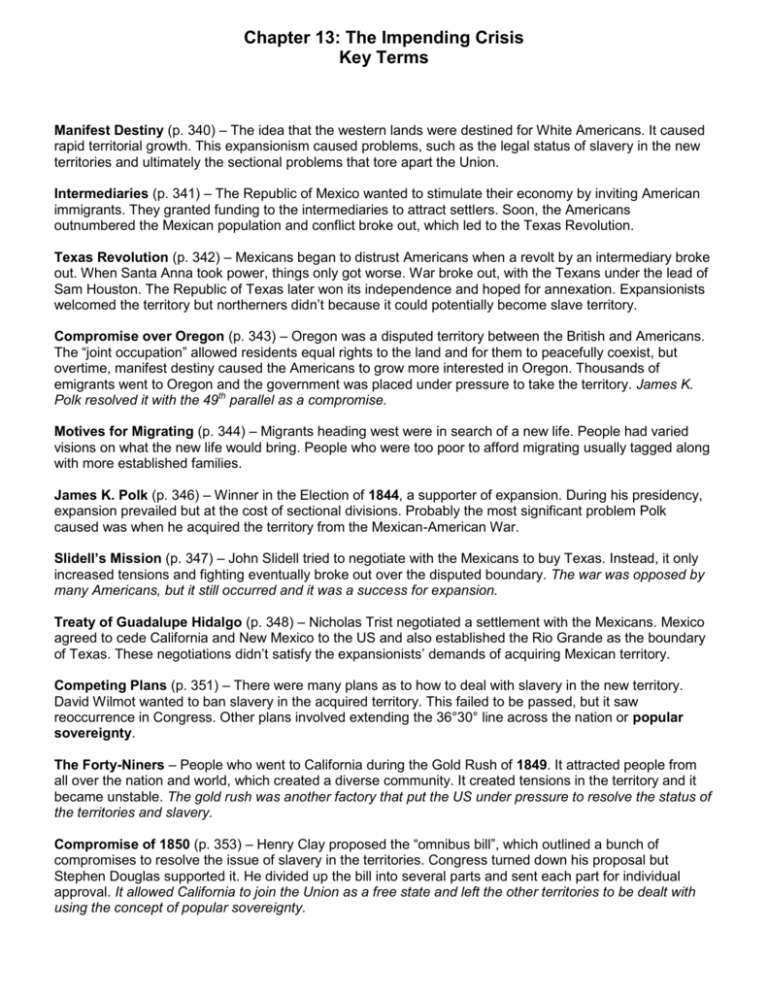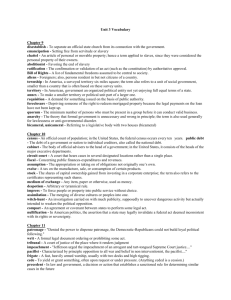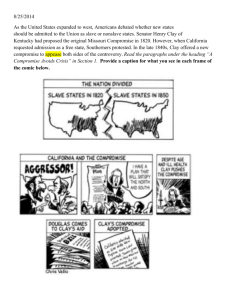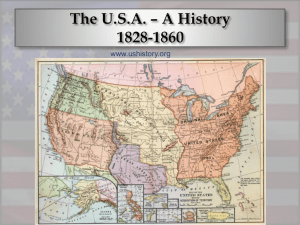ch. 13 key terms
advertisement

Chapter 13: The Impending Crisis Key Terms Manifest Destiny (p. 340) – The idea that the western lands were destined for White Americans. It caused rapid territorial growth. This expansionism caused problems, such as the legal status of slavery in the new territories and ultimately the sectional problems that tore apart the Union. Intermediaries (p. 341) – The Republic of Mexico wanted to stimulate their economy by inviting American immigrants. They granted funding to the intermediaries to attract settlers. Soon, the Americans outnumbered the Mexican population and conflict broke out, which led to the Texas Revolution. Texas Revolution (p. 342) – Mexicans began to distrust Americans when a revolt by an intermediary broke out. When Santa Anna took power, things only got worse. War broke out, with the Texans under the lead of Sam Houston. The Republic of Texas later won its independence and hoped for annexation. Expansionists welcomed the territory but northerners didn’t because it could potentially become slave territory. Compromise over Oregon (p. 343) – Oregon was a disputed territory between the British and Americans. The “joint occupation” allowed residents equal rights to the land and for them to peacefully coexist, but overtime, manifest destiny caused the Americans to grow more interested in Oregon. Thousands of emigrants went to Oregon and the government was placed under pressure to take the territory. James K. Polk resolved it with the 49th parallel as a compromise. Motives for Migrating (p. 344) – Migrants heading west were in search of a new life. People had varied visions on what the new life would bring. People who were too poor to afford migrating usually tagged along with more established families. James K. Polk (p. 346) – Winner in the Election of 1844, a supporter of expansion. During his presidency, expansion prevailed but at the cost of sectional divisions. Probably the most significant problem Polk caused was when he acquired the territory from the Mexican-American War. Slidell’s Mission (p. 347) – John Slidell tried to negotiate with the Mexicans to buy Texas. Instead, it only increased tensions and fighting eventually broke out over the disputed boundary. The war was opposed by many Americans, but it still occurred and it was a success for expansion. Treaty of Guadalupe Hidalgo (p. 348) – Nicholas Trist negotiated a settlement with the Mexicans. Mexico agreed to cede California and New Mexico to the US and also established the Rio Grande as the boundary of Texas. These negotiations didn’t satisfy the expansionists’ demands of acquiring Mexican territory. Competing Plans (p. 351) – There were many plans as to how to deal with slavery in the new territory. David Wilmot wanted to ban slavery in the acquired territory. This failed to be passed, but it saw reoccurrence in Congress. Other plans involved extending the 36°30° line across the nation or popular sovereignty. The Forty-Niners – People who went to California during the Gold Rush of 1849. It attracted people from all over the nation and world, which created a diverse community. It created tensions in the territory and it became unstable. The gold rush was another factory that put the US under pressure to resolve the status of the territories and slavery. Compromise of 1850 (p. 353) – Henry Clay proposed the “omnibus bill”, which outlined a bunch of compromises to resolve the issue of slavery in the territories. Congress turned down his proposal but Stephen Douglas supported it. He divided up the bill into several parts and sent each part for individual approval. It allowed California to join the Union as a free state and left the other territories to be dealt with using the concept of popular sovereignty. Ostend Manifesto (p. 355) A diplomatic attempt to buy Cuba from Spain by Franklin Pierce, who wanted to redirect attention from slavery. This attempt actually caused sectional debate when it was leaked out to the public. Northerners condemned it as an attempt to create a new slave state, while the south refused to acquire territory that doesn’t allow slavery. Transcontinental Railroad – There was debate as to where the eastern terminus of the railroad should be. This railroad was becoming necessary for improved communication between the east and west. The Gadsden Purchase acquired a strip of land in modern day Arizona and New Mexico for $10 million, which only elevated the sectionalist feelings. The Kansas-Nebraska Act (p. 356) Created the Nebraska and Kansas (likely to become a slave state) territory and repealed the Missouri Compromise. The Kansas-Nebraska Act destroyed the Whig party and divided northern democrats, but most importantly it created the new Republican Party. “Bleeding Kansas” (p. 357) – Kansas had many conflicts between the pro-slavery and anti-slavery supporters there. Since they legalized slavery, and Pierce was a pro-slavery supporter, they sacked Lawrence, the main headquarters of antislavery in Kansas. John Brown, in revenge, massacred five proslavery supporters. Violence and guerilla warfare ensued for years as a result. This violence only made the Union more divided. Pro-Slavery Argument (p. 359) – Argued that slavery was good for the nation as a whole and that it was the only way the two races could peacefully coexist. Election of 1856 – James Buchanan, the democrat from Pennsylvania, won over Fremont and Fillmore. He was an indecisive president at a very important time period in history. During his time in office, the country fell into a depression that lasted many years. The Dred Scott Decision (p. 361) – Dred Scott, a Missouri slave, was taken to Illinois and Wisconsin, where slavery was banned. He sued his master’s widow for freedom after his master died, and so he became free. But the widow’s brother claimed ownership of Scott. The court repealed their previous ruling and ruled that as a slave, he had no right to sue and had no citizenship. Congress had no authority to pass a law depriving people of their (slave) property, so this decision ruled the Missouri Compromise as unconstitutional. Lincoln-Douglas Debates (p. 362) – Lincoln and Douglas ran for the senate seats. They held great debates in the process, which Lincoln received national recognition from. Lincoln was against slavery but was not an abolitionist. John Brown’s Raid (p. 363) – John Brown wanted to lead an armed revolt, so he successfully captured an arsenal at Harper Ferry. However, he was captured and executed. His raid convinced white southerners that they could no longer live safely in the Union. Election of 1860 – The Election of 1860 was when President Lincoln was elected. Lincoln was the unanimous choice for the Republicans while the Democrats nominated Breckinridge and Douglas. The conditions in which Lincoln won led to disunion, since the southerners now thought the Union was a lost cause.





